Michael Segalov finds himself transfixed by Earth’s last great wilderness as he joins a month-long polar expedition to Antarctica
It’s going to get easier, I think to myself, as I lie in bed in the darkness, one hand gripping tightly the edge of the mattress, the other pressing hard on the spot where my head just thudded loudly, again, into a wall. In the bunk below, my cabinmate Oleg is dozing deeply. I might not be sleeping yet, but I will once I’ve found my sea legs. I’ve come a long way, I try to reassure myself, considering it’s only my fourth night at sea.
When I arrived on board my temporary new home, Greenpeace’s MV Esperanza, even successfully navigating my way to the bathroom along the ex-Soviet firefighting ship’s labyrinth of narrow corridors had seemed impossible. The environmental NGO had invited me to join them on a month-long polar expedition departing from Patagonia, the final leg of a year-long project to draw attention to the existential threats facing the world’s oceans. The crew had set off from London, before travelling from pole to pole.
Cruising along the Beagle Channel on our first morning – the calm, breathtaking 240km strait of water we’d sailed through after departing from Ushuaia, on the southern-most tip of Argentina – had lulled me into a false sense of security. “It is scarcely possible to imagine anything more beautiful than the beryl-like blue of these glaciers,” Charles Darwin wrote of the strait, after an expedition here in the 1830s. He was right. Mainland Argentina on one side, Chilean islands on the other, we’d been smoothly delivered from the final frontiers of South America towards Cape Horn and out into open oceans, passing snow-capped mountains and luscious greenery – albatrosses, whales and dolphins escorting us from above and below.

When I arrived on board my temporary new home, Greenpeace’s MV Esperanza, even successfully navigating my way to the bathroom along the ex-Soviet firefighting ship’s labyrinth of narrow corridors had seemed impossible. The environmental NGO had invited me to join them on a month-long polar expedition departing from Patagonia, the final leg of a year-long project to draw attention to the existential threats facing the world’s oceans. The crew had set off from London, before travelling from pole to pole.
Cruising along the Beagle Channel on our first morning – the calm, breathtaking 240km strait of water we’d sailed through after departing from Ushuaia, on the southern-most tip of Argentina – had lulled me into a false sense of security. “It is scarcely possible to imagine anything more beautiful than the beryl-like blue of these glaciers,” Charles Darwin wrote of the strait, after an expedition here in the 1830s. He was right. Mainland Argentina on one side, Chilean islands on the other, we’d been smoothly delivered from the final frontiers of South America towards Cape Horn and out into open oceans, passing snow-capped mountains and luscious greenery – albatrosses, whales and dolphins escorting us from above and below.

Stepping out into the crisp morning, though, a surprise is waiting. Three huge, jagged icebergs, somehow both deep blue and ghostly white in the orange light of dawn, jut out from the water right in front me, almost welcoming me into a corner of the world I imagined I’d only ever see on screen. A raft of penguins swims alongside. I’m channelling David Attenborough through my delirium. My stomach stirs with excitement – my first encounter with the Earth’s last great wilderness is all that I’d hoped for.
While landscapes come and go, and weather switches from blissful summer sunshine to blizzard and back again with little warning, the routine on board remains reassuringly constant. At 7.30am there’s a wake-up call while a help-yourself-breakfast wraps up in the mess. From 8 to 9am everyone pitches into the cleaning, and then the crew of 30 heads off to work. On the decks below, engineers and fitters keep us moving; from the bridge, mates navigate. A team of deckhands dutifully ensures everything is in working order, while chef Willy prepares lunch for midday. A queue forms at his hatch on the dot.
Unless you’re on watch duty, clocking off is at 5pm – just in time for an unofficial exercise class in the helicopter hangar or a smoke on the poop deck – before dinner is served up at 6pm. All the while, a small group of investigators, researchers and activists are plotting in a makeshift office. Because while the permanent crew keeps the boat running, it’s these campaigners who truly set its course.
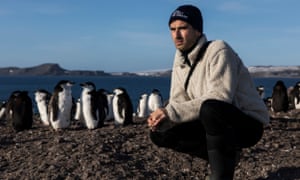
After arriving in the Antarctic proper three days earlier, we’ve anchored in a sheltered bay off the South Orkneys. Glaciers lead down to the water, which is peppered with icebergs. On a distant shoreline, a smattering of structures marks the British Antarctic Survey’s Signy Island Base. The waters might have calmed, but on board the atmosphere is anything but tranquil.
"Three huge icebergs appear, deep blue against the orange light of dawn"
Surrounded by maps, charts and laptops, Sophie Cooke, the mission’s lead investigator, is in the campaign room holding a briefing on a direct action set to take place the following morning.
Transhipping, Cooke explains, is how fishing boats transfer their catch on to cargo vessels while at sea, swapping fish for fuel, workers and supplies. It’s a system that allows fishing operations to maximise profits, simultaneously making it possible to travel into distant waters with almost no need to return to port. Earlier that day, Greenpeace had published a report that was three years in the making; it set out the harm transhipping can do, both to the oceans and the fishermen on board.
It’s how, Greenpeace argues, illegal and unregulated fish are laundered into the market, which is estimated to be worth between $10bn and $23.5bn annually. (“Dodgy fish” is mixed together in freezers with more sustainable, better regulated catch.) Human rights abuses at sea – including poor working conditions and modern slavery – are well documented, and by transhipping, beyond scrutiny and national jurisdiction, such malpractice is too often out of sight and out of mind. There are three transhipment boats (known as reefers) currently in the South Orkneys, I’m told. Using complex satellite mapping and ship-tracking software, Cooke and her team have identified one of them – a cargo vessel they suspect has dodgy fish on board.
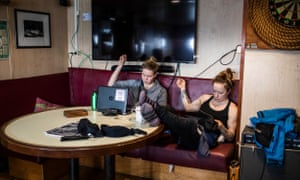
The next morning, from a speedboat, I watch as the team pulls together with military precision. The distinction between crew and campaigner melts away.
Everyone on board has a story explaining how they ended up here. It’s not the sort of job you can stumble into. For deckhand Usnea Granger, time spent fighting to save ancient Oregon woodland from deforestation as a teenager inspired her to pursue environmental activism. Chief mate Adrian Arauz describes the fields and rivers of his childhood in rural Panama. “It was instilled in me from an early age that we should take care of our surroundings, because in the end it’s nature that provides.”
It was an oil spill off the coast of Galicia in northwestern Spain that first got a young Fernando Romo interested in marine conservation. He recalls with vivid clarity a childhood memory: walking down to the beach in his hometown to be greeted by washed-up dead wildlife, the sand drowning in crude oil. While working on a commercial tanker ship in the 1990s, he and his team were tasked with pumping oil-infused water into the sea. Soon after he became a member of Greenpeace. He was working on their ships by 2008, and promoted to the role of captain in 2017.
Compared to my digs, Romo’s cabin is practically palatial. There’s an office with room for a desk and sofa, and penguin postcards pinned to a noticeboard. A thin curtain separates his sleeping quarters from where we’re sitting.

This adds another layer of responsibility and risk to Romo’s workload. He’s not just a sailor, he’s an activist, too. It means breaking laws and putting the boat into situations that most other captains would do everything in their power to avoid.
"I become spoilt. The whales aren't as close as the last pod we spotted"
That, Romo says, is how he stays positive. Eco-anxiety and burnout are common among environmental campaigners. I’d have imagined that spending every waking hour fighting for the planet’s future while witnessing firsthand parts of the world most vulnerable to the effects of climate catastrophe might be hard to handle.
I don’t know why, but I arrived in the Antarctic expecting to come face to face with our shared, dystopian future. I thought that seals were going to be choking on plastic bags, that chunks of once pristine icebergs were going to be melting into piles of greyish mush. I thought it might trigger alarm bells. Instead, the air is fresher than any I’ve ever breathed, there’s wildlife in abundance, the seawater runs clear.
But being here is an eerie reminder that we can’t wait for the consequences of climate change to be visible in places like this – it will be far too late by then. It’s no coincidence, I’m realising, that the only continent with no permanent population and few visitors is also the one in which nature has best survived the most damaging effects of humankind. And far from despairing, I feel myself becoming more determined than ever to help preserve this unsoiled natural world. It’s suddenly real, no longer an idea in the abstract, or a scene on TV. Spending time with people who’ve given their lives to defending it is a stark reminder that most of us can, and must, play a bigger part in its survival, if we’re to turn the tide.
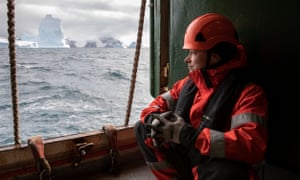
Two or three weeks in, I’ve lost track of time completely. The team has turned its eye to scientific research. A high-tech underwater robot camera scours the seabed for trash and mysterious species, and we visit the colossal A-68, the largest iceberg to have broken off from the shelf. (It is twice the size of Luxembourg.) Through the mist, it stretches out as far as the eye can see in every direction, a sinister omen of what further global warming might bring.
From the South Orkneys we sail closer to the Antarctic Peninsula, a strip of the continent that protrudes northwards into more navigable waters. I become spoilt: a few whales spotted starboard aren’t as close as the last pod; with notes on a whiteboard updating me, the idea of having to plan my own day feels like a drag.
There’s on-board wifi keeping me connected to civilisation, although how it works remains a mystery. (It involves, I’m told, a complicated satellite system.) Just a few years ago, being at the end of the world meant losing touch completely. If, say, a panic-inducing medical epidemic happened to sweep the world, you wouldn’t hear about it. I’m grateful I can Skype my family, but while being online is convenient, a part of me was hoping for a little more isolation. I wanted to switch off and experience time spent truly off-grid. Instead, I’m scrolling through Instagram, responding to work emails as if I’m sitting at my London desk. But then, one particularly bumpy afternoon, I drop my iPhone when a big wave hits, and the screen smashes to pieces, so I surrender myself completely to my life at sea.
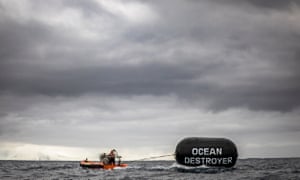
Conveniently for me, however, Greenpeace doesn’t just want to highlight destruction. With a team of photographers, videographers and social media types they want to document the continent’s beauty – to capture just what is at risk.
A short trip in the speedboat and I’m standing alone on a green, mossy carpet atop a hill on Barrientos Island. Thousands of chinstrap and gentoo penguins are standing, swimming and shitting on all sides. In front of me, the infinite, silky ocean. Behind, mountains drenched in sun and thick, white snow. It’s bliss. Too soon, it’s time to head back to the Esperanza. A few days later, we’ll begin our long journey home.
The sound of us upping anchor for a final time brings with it a sudden panic. My month at sea has left me institutionalised: once I disembark who’ll cook my lunch, pick the film, tell me when and where to be? Most of all, though, I fear I’ve taken my time soaking up the Antarctic’s splendour for granted. Did I make the most of it? What will I do when I look through a window and all this magnificence just isn’t there? I suppose those last ones are probably questions we all have to grapple with. Unless there’s a radical shift in how we interact with our precious planet, there might well come a day when we look up and it’ll have disappeared for good.
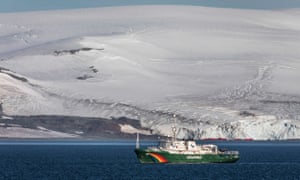
No comments:
Post a Comment